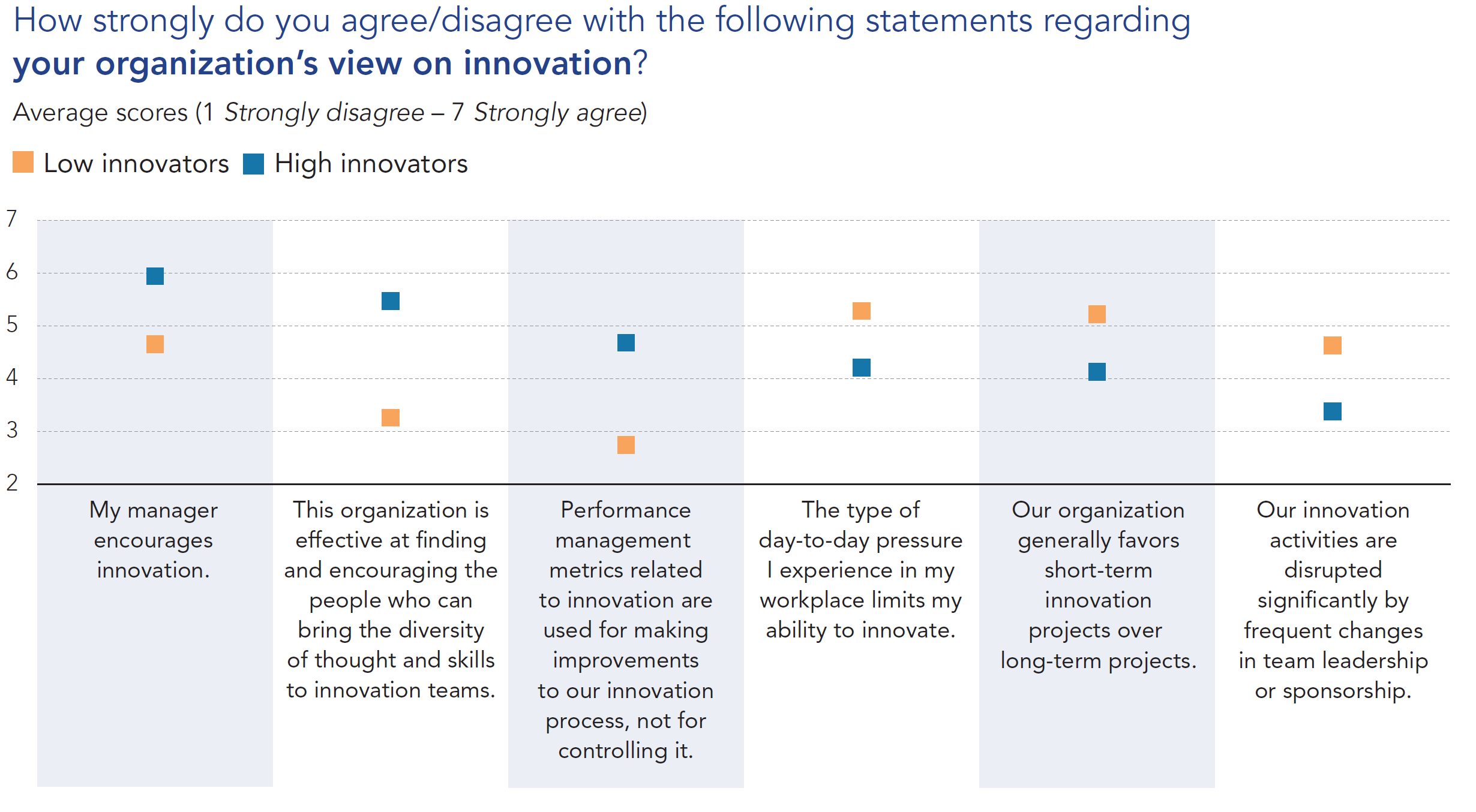Executives have often confided to me that employees’ jobs are difficult enough without having to think of new products and services or better ways of doing their jobs. Besides, they cannot afford to have people lose their focus on this quarter’s numbers for next year’s innovation.
But in a crisis, and certainly the COVID19 crisis, it is evident that if companies do not do things differently, they may not be here next year.
Wise executives know they must innovate in order to significantly improve their company’s performance in a crisis. And to achieve this goal, they must tap into the intrinsic individual motivators that all employees possess.
Your best employees enjoy being part of a successful solution in a crisis. Executives need to be transparent about the challenges facing the company, ask for employee suggestions, listen, and enable other employees to build upon their ideas.
Our most recent report, “Useful and Emerging Practices from Highly Innovative Organizations in The Digital Era,” with The Conference Board, shows that the manager’s role is critical for generating innovation. In the chart below, highly innovative organizations, represented by the blue dots, have higher percentages of managers that encourage innovation.
But the manager’s role tells only part of the story. Employees in highly innovative organizations report less stress in the workplace than less innovative organizations even when innovating. (Please see the fourth panel from the left in the chart below). Why? When work aligns with employees’ intrinsic goals, when their contributions are noticed, and when they have trust in each other and their leaders, they will make extraordinary efforts.
In addition, when the highly innovative organization changes the sponsor of team or the leader of a team, it is not as disruptive to the team among the highly innovative companies. Why? Because the employees know the organization’s culture and systems will continue to support innovation. Meanwhile, among the low innovators (represented in the chart by the orange dots), there is less success when team leaders or sponsors are changed. In those organizations, it is often a single sponsor or team leader who is the innovation champion in these cultures, which tend to be more insular and resistant to change.
There are two other secrets of the highly innovative organizations over the less innovative ones.
The first is that their talent managers are nimble at finding talent with the diverse technical expertise, life experiences, and thinking that leads to innovation. In the chart below (the second panel), the highly innovative organizations score their highest difference over the low innovators in this area of finding and encouraging employees with unique skills and diverse thinking. Just as importantly, the highly innovative organizations are better at supporting their diverse thinkers to raise and pursue innovation. (Learn more on the importance of “mavericks” and their role with innovation).
The second is that they have changed their performance management systems to encourage and reward innovation. This includes supporting prototyping and experimentation, and all the failed tests and learning to improve their understanding of new technology, processes, and techniques, required to commercialize innovation successfully. Please note the third panel on the chart below. Highly innovative organizations score their second-highest difference with low innovators in this area.
Changes to performance management systems come in two areas: the performance management of employees and the performance management of an organization’s collaboration and agility to commercialize innovation.
Performance management of employees
Research on performance management and innovation is conclusive. Performance management systems that put a premium on managers providing timely development and employee feedback and building trust are better at supporting innovation cultures. In addition, organizations that stop using forced ranking, employee ratings, and taking out the bottom five or 10 percent of employees according to performance do better with innovation. Why? Because when employees know that only 15 percent of them can get the highest rating, their team collaboration turns to competition, which saps innovation. Just as destructive, they stop making suggestions they believe top management does not want to hear so they don’t ruin their changes for promotion or land on the next layoff list.
Performance management systems that encourage innovation often list values such as collaboration and sharing knowledge in their rating systems. Using OKR goal setting they set tough goals and expect employees to fail at 30% of their goals. Why? Because if employees are not pushing the edges, they and their organizations are not being innovative. Goal setting in these organizations is about learning and moving forward rapidly with intent of commercializing innovation quickly.
I was part of changing performance management systems at Medtronic. When we removed our forced ranking and performance ratings, we saw a dramatic increase in employees’ willingness to listen to the development and performance feedback of their managers. Collaboration also improved and they trusted their managers more.
Performance management for organizational collaboration and agility to commercialize innovation
Organization-wide performance management needs to encourage multi-discipline collaboration, to enhance organizational agility, and to speed the commercialization of new ideas. Having back-office organizations come together to define their collective processes and hand-offs, and to eliminate redundancies, delays, and errors can be a daunting task for organizations. It means questioning long-held beliefs and habits.
It takes the following seven steps to be successful:
- CEO set a clear and compelling vision and enthusiastically promotes it
- Executive leaders collaborate closely
- The company invests in needed technology, employee skills, and organizational learning
- Each team is involved and prepared to innovate
- Managers encourage innovation, provide feedback and reward failure to promote learning
- There are team and enterprise-wide rewards for success.
- Organizations improve multi-discipline collaboration and agility.
Companies taking these steps will substantially improve their innovation and financial success. At Honeywell Space Systems, we had a significant issue with commercializing our innovations rapidly. We were able to significantly reduce our delays in delivering new products and services on-time from 63% to 100%. We also enjoyed significant improvements in profitability.
Executives who dither and delay with innovating in a crisis are the ones leading their organizations to failure through neglect.
Please take advantage of a crisis to rally your employees to innovate for a common purpose, follow your lead, and provide your organization the solutions it needs to survive the crisis.
If you would like to take advantage of this crisis to rally your employees to innovate for a common purpose and follow your lead, download the free report “Useful and Emerging Practices from Highly Innovative Organizations in The Digital Era.”
Victor Assad is the CEO of Victor Assad Strategic Human Resources Consulting and managing partner of InnovationOne. He works with companies on their post-COVID19 transformations, and to improve their recruiting, HR operations, and develop extraordinary leaders, teams, and cultures of innovation. His new book is Hack Recruiting: the Best of Empirical Research, Method and Process, and Digitization. Subscribe to his weekly blogs at www.VictorHRConsultant.com.


